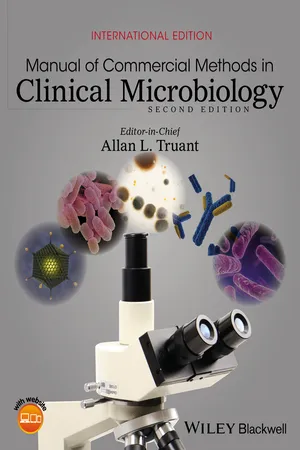
Manual of Commercial Methods in Clinical Microbiology
- English
- ePUB (adapté aux mobiles)
- Disponible sur iOS et Android
Manual of Commercial Methods in Clinical Microbiology
À propos de ce livre
The Manual of Commercial Methods in Clinical Microbiology 2 nd Edition, International Edition reviews in detail the current state of the art in each of the disciplines of clinical microbiology, and reviews the sensitivities, specificities and predictive values, and subsequently the effectiveness, of commercially available methods – both manual and automated. This text allows the user to easily summarize the available methods in any particular field, or for a specific pathogen – for example, what to use for an Influenza test, a Legionella test, or what instrument to use for identification or for an antibiotic susceptibility test.
The Manual of Commercial Methods in Clinical Microbiology, 2 nd Edition, International Edition presents a wealth of relevant information to clinical pathologists, directors and supervisors of clinical microbiology, infectious disease physicians, point-of-care laboratories, professionals using industrial applications of diagnostic microbiology and other healthcare providers. The content will allow professionals to analyze all commercially available methods to determine which works best in their particular laboratory, hospital, clinic, or setting.
Updated to appeal to an international audience, The Manual of Commercial Methods in Clinical Microbiology, 2 nd Edition, International Edition is an invaluable reference to those in the health science and medical fields.
Foire aux questions
Informations
CHAPTER 1
Role of the US Food and Drug Administration in the Regulation of Clinical Microbiology Devices
1.1 Historical overview of in vitro diagnostics
1.1.1 Device classification via the MDA of 1976
- In vitro diagnostic products are those reagents, instruments, and systems intended for use in the diagnosis of disease or other conditions, including a determination of the state of health, in order to cure, mitigate, treat, or prevent disease or its sequelae. Such products are intended for use in the collection, preparation, and examination of specimens taken from the human body. These products are devices as defined in section 201(h) of the Federal Food, Drug, and Cosmetic Act (the act), and may also be biological products subject to section 351 of the Public Health Service Act.
- A product class is all those products intended for use for a particular determination or for a related group of determinations or products with common or related characteristics or those intended for common or related uses. A class may be further divided into subclasses when appropriate.
- Class I, general controls, includes devices which appear to pose relatively little risk to human health and for which a series of general controls are believed sufficient to ensure safety and effectiveness. The controls include regulations that: (i) prohibit the sale of adulterated or misbranded devices; (ii) require domestic device manufacturers and initial distributors to register their establishments with the FDA and provide the FDA with a list of all devices being sold before the passage of the law (pre-amendment devices); (iii) grant the FDA authority to ban certain devices; (iv) provide for notification to the FDA of risks and of repair, replacement, or refund (recall); (v) restrict the sale, distribution, or use of certain devices; and (vi) govern good manufacturing practices, records and reports, and inspections. These requirements also apply to Class II and Class III devices.
- Class II devices are those for which general controls alone are insufficient to assure safety and effectiveness, and existing methods are available to provide such assurances. In addition to complying with general controls, Class II devices are also subject to special controls. Special controls may include special labeling requirements, mandatory performance standards, and post-market surveillance.
- Class III devices are usually those that support or sustain human life, are of substantial importance in preventing impairment of human health, or which present a potential, unreasonable risk of illness or injury. In many cases there is insufficient information to ensure that general controls and performance standards will provide assurance that the devices are safe and effective. New devices are assigned to Class III until they are found to be substantially equivalent to a pre-amendment device (Class I or II) or are reclassified as Class I or II devices through the de novo petition program.